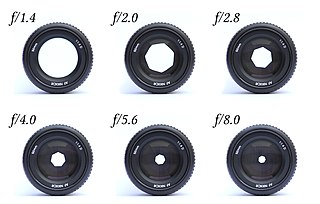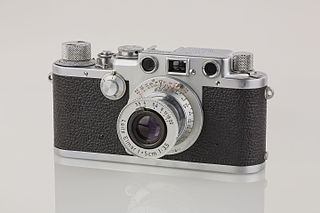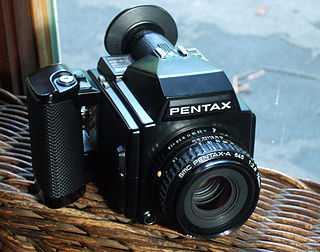
A single-lens reflex camera (SLR) is a camera that typically uses a mirror and prism system that permits the photographer to view through the lens and see exactly what will be captured. With twin lens reflex and rangefinder cameras, the viewed image could be significantly different from the final image. When the shutter button is pressed on most SLRs, the mirror flips out of the light path, allowing light to pass through to the light receptor and the image to be captured.

In optics, an aperture is a hole or an opening through which light travels. More specifically, the aperture and focal length of an optical system determine the cone angle of a bundle of rays that come to a focus in the image plane.

A camera is an optical instrument that captures a visual image. At a basic level, cameras consist of sealed boxes, with a small hole that allows light through to capture an image on a light-sensitive surface. Cameras have various mechanisms to control how the light falls onto the light-sensitive surface. Lenses focus the light entering the camera. The aperture can be narrowed or widened. A shutter mechanism determines the amount of time the photosensitive surface is exposed to light.

A twin-lens reflex camera (TLR) is a type of camera with two objective lenses of the same focal length. One of the lenses is the photographic objective or "taking lens", while the other is used for the viewfinder system, which is usually viewed from above at waist level.

Victor Hasselblad AB is a Swedish manufacturer of medium format cameras, photographic equipment and image scanners based in Gothenburg, Sweden. The company originally became known for its classic analog medium-format cameras that used a waist-level viewfinder. Perhaps the most famous use of the Hasselblad camera was during the Apollo program missions when the first humans landed on the Moon. Almost all of the still photographs taken during these missions used modified Hasselblad cameras. In 2016, Hasselblad introduced the world's first digital compact mirrorless medium-format camera, the X1D-50c, changing the portability of medium-format photography. Hasselblad produces about 10,000 cameras a year from a small three-storey building.

In photography, shutter speed or exposure time is the length of time that the film or digital sensor inside the camera is exposed to light when taking a photograph. The amount of light that reaches the film or image sensor is proportional to the exposure time. 1⁄500 of a second will let half as much light in as 1⁄250.

Leica Camera AG is a German company that manufactures cameras, optical lenses, photographic lenses, binoculars, rifle scopes and microscopes. The company was founded by Ernst Leitz in 1869, in Wetzlar, Germany.

Contax began as a camera model in the Zeiss Ikon line in 1932, and later became a brand name. The early cameras were among the finest in the world, typically featuring high quality Zeiss interchangeable lenses. The final products under the Contax name were a line of 35 mm, medium format, and digital cameras engineered and manufactured by Japanese multinational Kyocera, and featuring modern Zeiss optics. In 2005, Kyocera announced that it would no longer produce Contax cameras. The rights to the brand are currently part of Carl Zeiss AG, but no Contax cameras are currently in production, and the brand is considered dormant.

The Nikon F-501 was the first successful autofocus SLR camera sold by the Nikon Corporation beginning in 1986. A nearly identical, albeit manual focus version, called the Nikon F-301 was also available. Subsequent models in the consumer line included the Nikon F-401, Nikon F-601, and Nikon F-801 / F-801s.

The Canon EF is a manual focus 35mm single-lens reflex camera produced by Canon between 1973 and 1978. It was compatible with Canon's FD-mount lenses. The EF was built as an electro-mechanical version of Canon's top-of-the line wholly mechanical Canon F-1. The shutter is mechanical at all speeds starting at 1/2 second and faster, but from 1 second and beyond the shutter is all electric, allowing for AE shutter speeds as long as 30 seconds. The EF shares the F-1's rugged construction and tough metal body. Unlike the F-1, the EF does not support any motor drive for film transport. Neither does it provide any interchangeable viewfinder.

The Canonflex is a Canon 35 mm film single-lens reflex (SLR) camera introduced in May 1959. Its standard lens is the Canon Camera Co. Super-Canomatic R 50mm lens f/1.8. The camera was in production for one year before it was replaced by the Canonflex R2000, adding a 1/2000 sec. shutter speed.

Image stabilization (IS) is a family of techniques that reduce blurring associated with the motion of a camera or other imaging device during exposure.

Sports photography refers to the genre of photography that covers all types of sports.

The Nikkorex nameplate was used for a series of 35 mm film, single-lens reflex cameras sold by Japanese optical manufacturer Nippon Kogaku K.K., as well as a series movie cameras and movie projectors. The models, made by other companies, were designed and marketed as low-cost, feature-reduced equipment for the consumer market.

The Konica Hexar RF is a 35 mm rangefinder camera which was sold by Konica. It was introduced to the market on 13 October 1999. and subsequently discontinued some time before the end of 2003. The camera used the "Bayonet Konica KM-mount", a copy of the Leica M-mount, thus sharing interchangeable lenses with those designed for Leica cameras and others compatible with them. The Hexar RF has a combined rangefinder/viewfinder modeled on that of Leica cameras, a similar body shape and size - and so is similar to Leica M-mount cameras in many aspects of operation.

The Minolta CLE is a TTL-metering automatic exposure aperture-priority 35 mm rangefinder camera using Leica M lenses, introduced by Minolta in 1980.

The Kodak Retina Reflex is a discontinued series of four single-lens reflex cameras made by Kodak, continuing the brand Kodak Retina.
The Pentax Q series is a series of mirrorless interchangeable-lens cameras made by Pentax and introduced in 2011 with the initial model Pentax Q. As of September 2012, it was the world's smallest, lightest interchangeable lens digital camera. The first models used a 1/2.3" back-illuminated sensor CMOS image sensor. The Q7, introduced in June 2013, uses a larger 1/1.7" type sensor. The Q system is now discontinued.

The Pentax 645 is a medium format single-lens reflex system camera manufactured by Pentax. It was introduced in 1984, along with a complementary line of lenses. It captures images nominally 6 cm × 4.5 cm on 120, 220, and 70 mm film, though the actual size of the images is 56 mm × 41.5 mm.

The Pentax Q is a mirrorless interchangeable-lens camera introduced by Pentax on June 23, 2011.